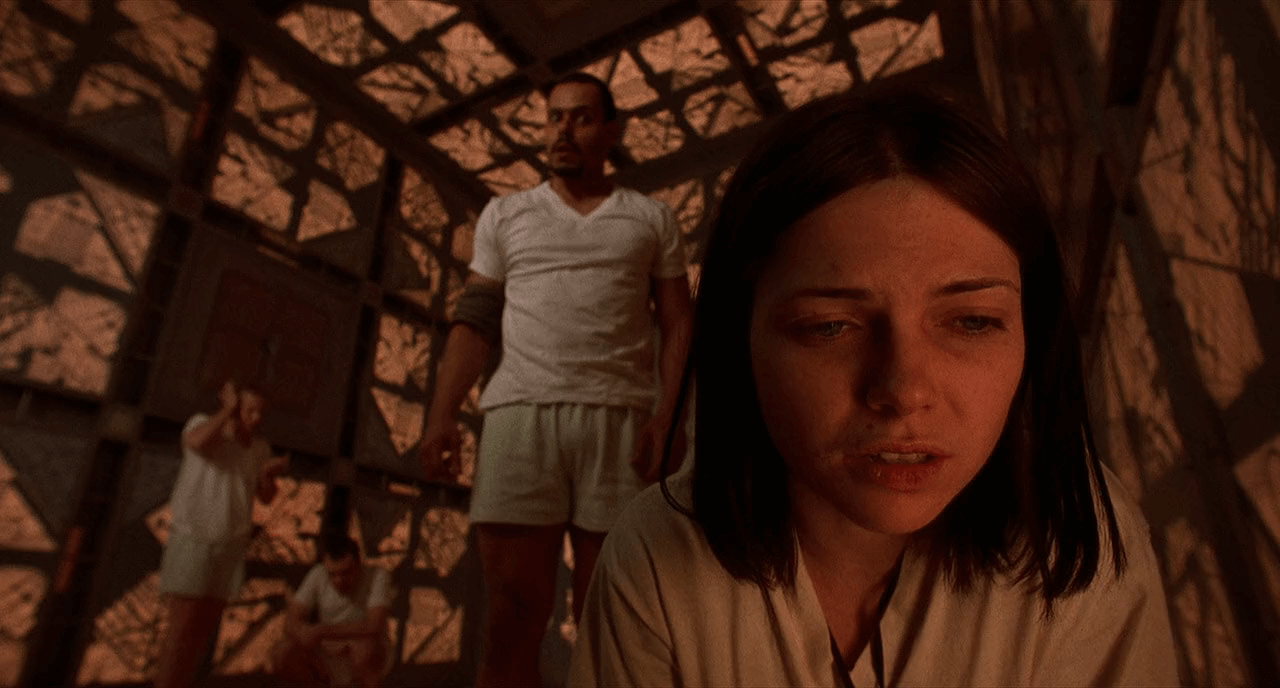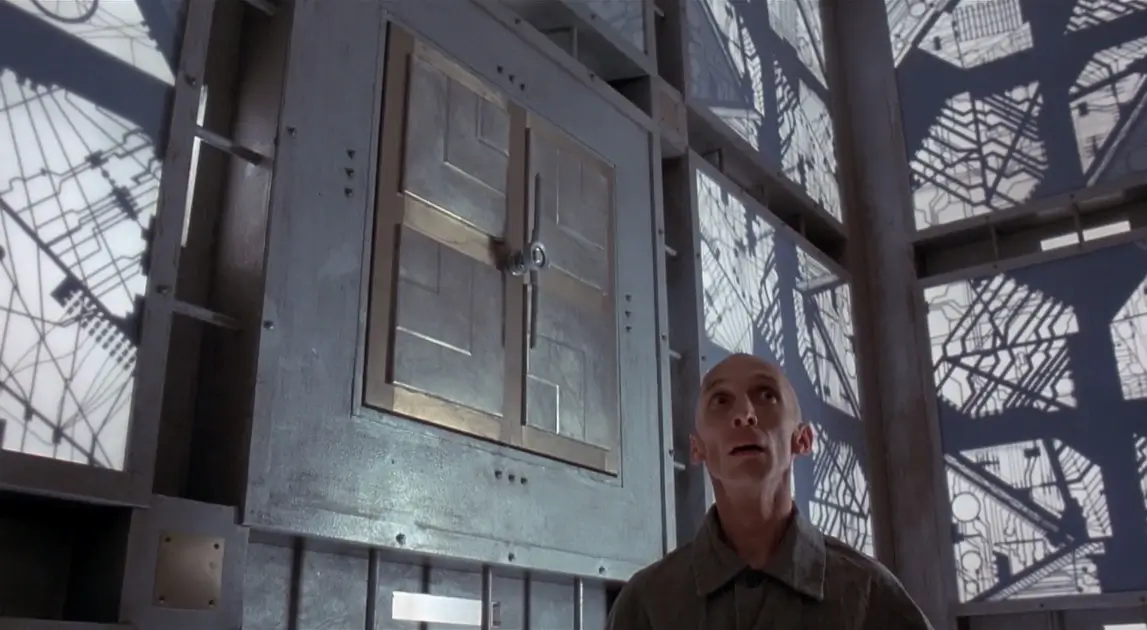CUBE. The ultimate science fiction maze explained

The first attribute refers to the situation of persecution in which the characters find themselves. Not knowing who imprisoned them or for what purpose, they desperately try to survive in a hopeless situation. The second element refers to the shape of the room, which serves as both a prison and a deadly trap for the characters. The cube is also a puzzle for them, and solving it will decide their survival.
The Creator of Cube
There are forgotten debuts, serving as warm-ups for the creator, and there are excellent debuts, turning out to be a bull’s-eye for the creator over the years. Cube belongs to the latter kind. This is especially interesting considering the almost express pace at which the film was made – the shooting lasted only twenty days. It was also a film with an exceptionally low budget – it cost only three hundred and sixty-five thousand Canadian dollars. However, these were sufficient funds to achieve the necessary quality. But the history of cinema contains at least a few examples of directors who, after the success of their first, great film, never came close to the level of their debut in their subsequent works. Canadian director Vincenzo Natali, unfortunately, is the executor of this curse.

However, the creator never aimed high, not caring about more publicity. After his full-length debut, several other films in the science fiction genre appeared in his filmography, quite good ones (Cypher, Nothing, Splice), but the creator still returned to the paths he had treaded before. As if suggesting that what was most interesting to say had been said in 1997. Two years after the premiere of Cube, science fiction cinema changed its face – a new era of big, fantastic spectacles based on dynamic action and visual effects, initiated by The Matrix, arrived. However, Natali was closer to the severity and realism, which is now boldly and successfully represented by none other than Denis Villeneuve (also a director from Canada). Perhaps this change in SF stylistics, which has now found its place in cinema, will make Natali surprise us soon with some full-length project.
There was once talk of Natali taking on the adaptation of Neuromancer – a true classic of science fiction literature, initiating the emergence of the cyberpunk subgenre. Unfortunately, the project fell through. Later, the director preferred to step into the shadows and focus on the position of a TV series director, which he had been doing even before Cube. He has recently worked on Westworld, but he also has directorial credits for episodes of TV series such as Hannibal, Virus, Luke Cage, American Gods.
However, let’s not kid ourselves – regardless of how his career turns out, Natali will forever remain the director of one cult film. Cube is an unmatched model of dark, raw science fiction imbued with an atmosphere of mystery.

Of course, by suggesting at the beginning that Vincenzo Natali constructed the plot for the film Cube using only the two mentioned elements, I am somewhat winking at the reader, realizing the conventionality of this assumption. In reality, the director and screenwriter had a more complex source of inspiration. Surely, Natali must have liked one of the episodes of the iconic TV series The Twilight Zone from 1964, titled Five Characters in Search of an Exit. As the title suggests, the episode is about five people who wake up trapped in a cylindrical room. Each character played a different role in real life (major, clown, hobo, ballerina, bagpiper), but they must start working together to face the threat. The script for the 1997 film was probably based on another work – the 1969 film titled The Cube, created by Jim Henson. In this case, the plot revolves around a man trapped in a white cube, whose main concern is how to escape. However, he is not helped by the occasional visitors, led by the director of this mysterious place.

Interpretation of Cube
It might be difficult for you to understand, but there is no conspiracy. No one is in control. It’s a headless, misguided operation that is the illusion of something bigger. Do you understand? Big Brother is not watching you.
These words are spoken by one of the characters in Natali’s film. To some extent, they explain what the sense and premise of the cube are – the place where the characters are confined. Contrary to appearances, the perspective in which no one supervises the prison gathering prisoners (interestingly, the names of the characters refer to the names of the most important prisons in the world), thus constituting a completely autonomous being, is the worst possible perspective. The chance of liberation and discovering the meaning of the place of persecution then drops to zero because no one pulls the strings of this sinister mechanism. But the greatest strength of the film’s plot concept Cube is that we, the viewers, add our interpretation to it. This is an open question. I like to see the cube as a metaphor for the life of a man or a socio-political system. In both cases, the beginning and the end of the mechanism in which we operate are unknown. Every step forward is effectively limited by the fear of consequences. When we finally manage to move, the burden of failure – a failure that in our imagination usually takes on deadly shapes – constantly hangs over us.

What is important is that a significant message flows from one of the plot twists of the film. Failure, i.e., death, never comes from above – it is rather a consequence of our choices, a reaction to our overwhelming need to move forward. Because if we could more often engage the brakes in life, wait, and think about the problem, much less evil would befall us.
I also like to see in the cube a place that not so much binds as it gives a chance for eternity. It is given to them in exchange for erasing the bad impression of the sins of earthly life. Cube is a purgatory – the characters end up in it right after death (they only remember that they went to sleep), and in it is a constant struggle to prove their worth in the face of the mysterious being whose name they do not know. The finale of this story, in which an intellectually disabled person, as one tainted only by original sin, manages to touch the whiteness of salvation as the only one, is then credible. Others fail because they forget the fundamental principle of survival (also favoring Christian truths) saying – in unity is strength! In other words, life in a community is the key to happiness, and individualism is the path to nowhere.

Resonance and Sequels
It seems that the biggest problem with later Cube sequels is the fact that they effectively dispel this electrifying aura of mystery, which is the hallmark of the original. Paradoxically, however, these are not such bad films – detached from comparisons to the original, they can be watched even painlessly. However, they are definitely bad sequels. Although Natali was offered the position of director for the second part, he did not share the idea of continuing the concept presented in the original, considering it closed. Andrzej Sekuła (Polish cinematographer living abroad), the director of Cube 2, expressed a different position and filmed it in 2002. The film suffers from the typical ailment of sequels, standing out with excessive showiness (to make matters worse, the special effects don’t look good either). Moreover, the cards of the story are revealed, which should have remained covered. However, the creators of the third part, titled Cube Zero, went the furthest in explaining the origin of the cube, which is a prequel to the entire story. The mystery is revealed, and we are given the solution to the puzzle. However, Cube Zero defends itself by telling the story from two different perspectives – the people trapped and those who control the trap.

Although the sequels try to follow the established pattern in the first film, surprising the viewer with new trap solutions and revealing additional secrets of the main plot, they clearly lose in competition with the original. They can only be treated as harmless curiosities trying to stand out against the exceptionalism of the source material. And thus, remaining in its shadow. But Cube from 1997 also managed to inspire filmmakers in a different way. Over the years, several films have been made that are based on a similar starting idea as Vincenzo Natali’s film – the confinement of characters in a room or a situation without an exit, a kind of rat maze that only seemingly has no way out. Such films include Identity, Killing Room, or the British Exam. But also the first Saw and, to some extent, its sequels drew the narrative backbone from Cube. For some time, there has been talk of an American remake of Vincenzo Natali’s work, which would be called Cubed. For now, nothing official is known about the production. Sooner or later, however, we will certainly return to the cube.
—
Reportedly, the first scene the director removed in post-production was the final shot outside the Cube, providing an answer to the key question. This decision is not surprising. The real strength of the cube as a trap where the characters find themselves lies in its purposelessness and randomness. The emptiness it thus defines seems to have no end – which is profoundly frightening. Only a few can give it meaning.

